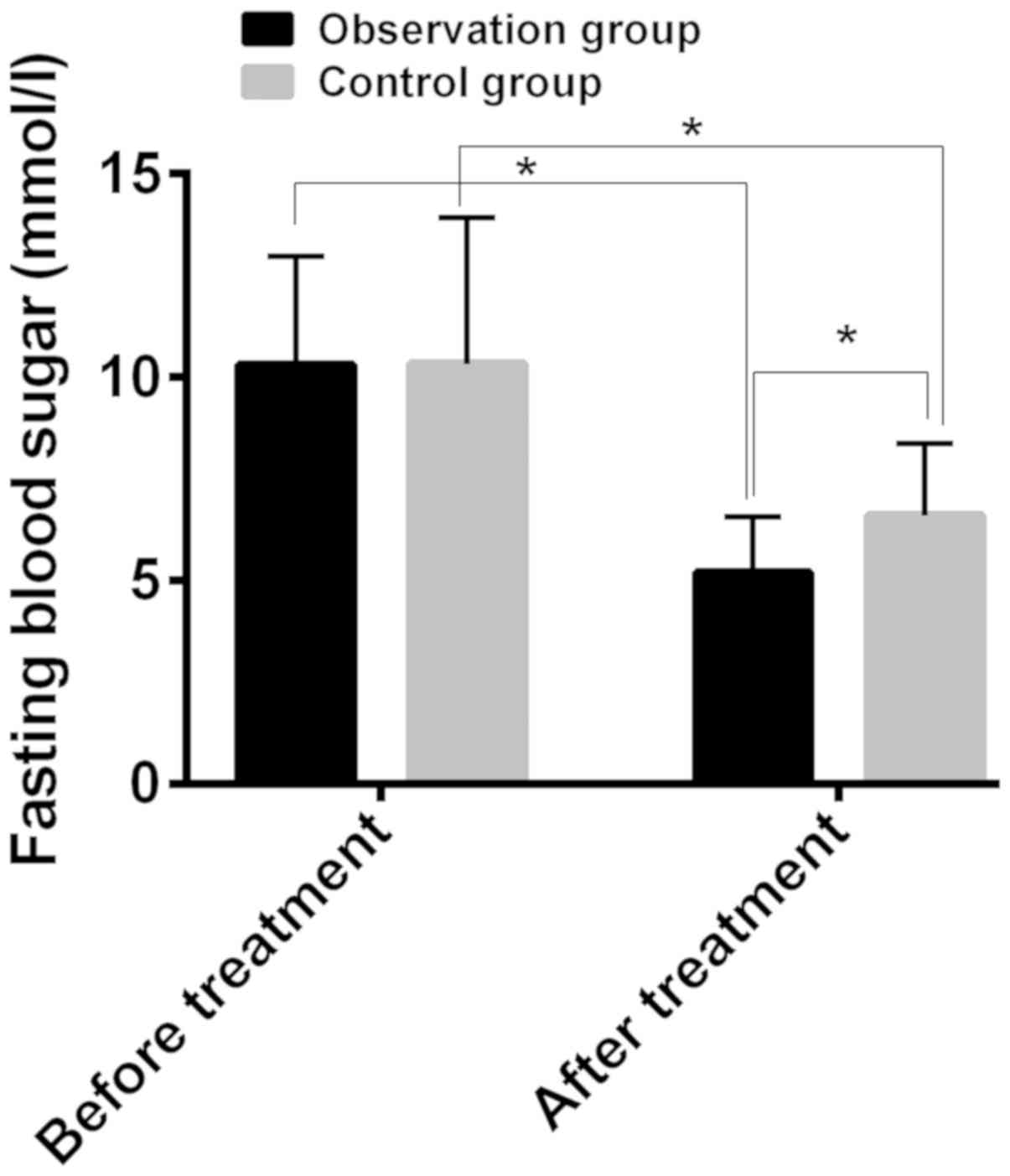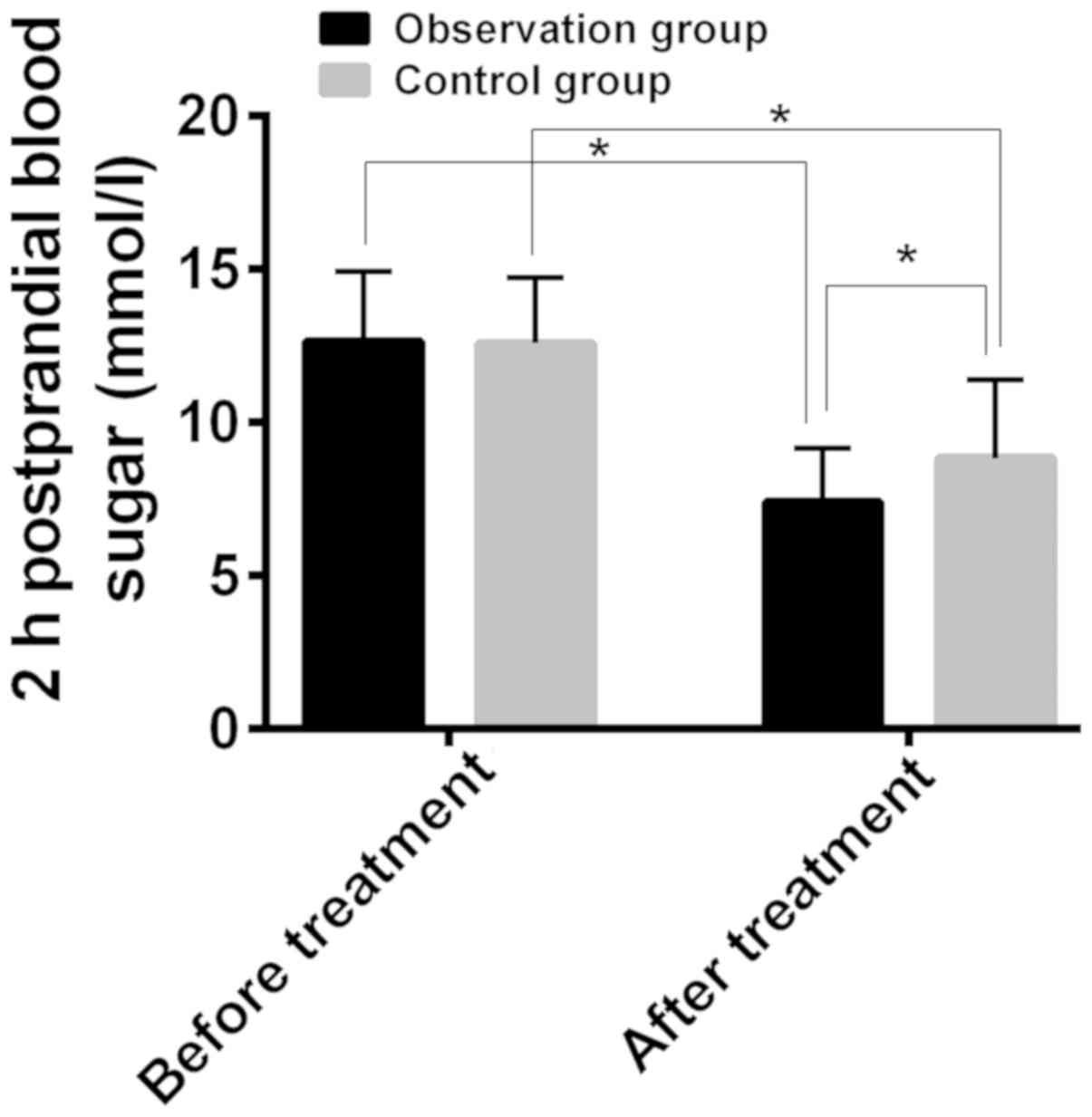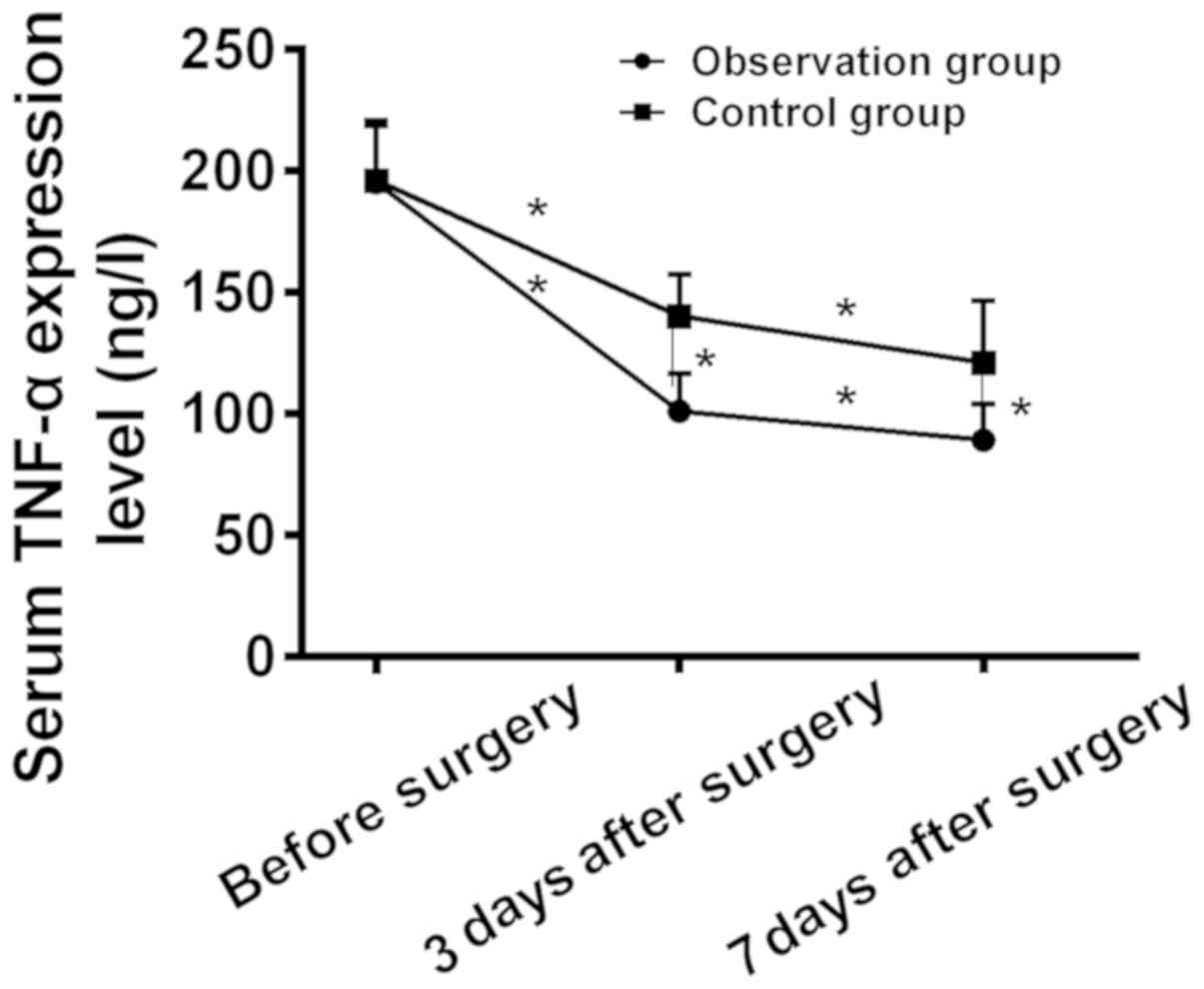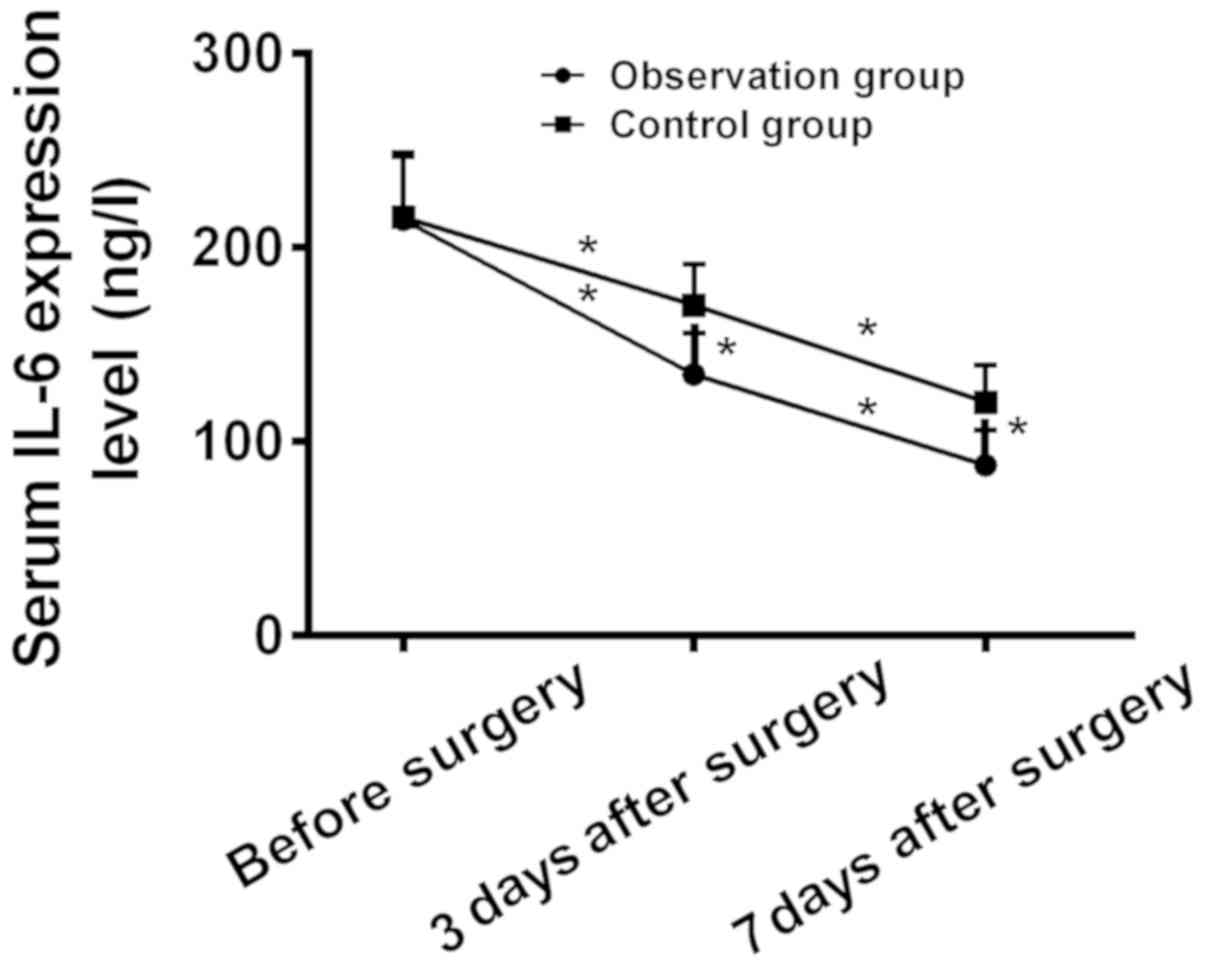Introduction
Diabetes is a common chronic disease in clinic.
Pancreatic dysfunction leads to hypoinsulinism in the body, which
increases sugar in blood and urine and eventually results in
diabetes and its complications (1,2). As one
of the common complications (3),
perianal abscess is a surgical disease caused by acute pyogenic
infection in the soft tissue and space around the anal canal or the
rectum. Generally speaking, operation is the most effective way to
treat perianal abscess, but their large wound surface usually
causes long postoperative recovery time (4,5).
Patients with diabetes who are in a hyperglycemic state for a long
time have poorer ability of anti-infection and resistance than
normal people, and surgical trauma easily leads to their reduction
of insulin secretion. As a result, the patients develop metabolic
disorders, which increase the difficulty and risk of a surgical
operation and seriously affect the postoperative healing of wound
surface, not conducive to the patients' prognosis (6,7).
Therefore, it is imperative to control the blood
glucose of patients with diabetes complicated with perianal abscess
in order to improve the operative efficacy and reduce the risk of
infections. The blood glucose of patients with diabetes is
controlled through insulin, which can be orally administered,
intravenously pumped or subcutaneously injected. Findings have
shown that different administrations of insulin have different
efficacy and safety (8). However,
the efficacy of the different administrations for patients with
diabetes complicated with perianal abscess has rarely been studied.
According to a study on the wound surface healing of perianal
abscess, tumor necrosis factor-α (TNF-α) and interleukin-6 (IL-6)
are representative inflammatory cytokines and they play an
important role during wound surface healing (9). Therefore, the efficacy of insulin with
different administrations for patients with diabetes complicated
with perianal abscess and its effects on the postoperative healing
of wound surface and serum inflammatory cytokines were explored in
this study, in order to provide a more appropriate scheme for the
treatment of the patients.
Materials and methods
General information
In total, 167 patients with type 2 diabetes who
underwent radical operation of perianal abscess in Jinhua Hospital
of Zhejiang University (Jinhua, China) from January 2014 to
December 2016 were retrospectively analyzed. There were 91 males
and 76 females, with an average age of 54.31±4.65 years and an
average course of diabetes of 4.31±1.29 years. Before and after the
operation, 89 patients who received continuous intravenous pumping
of insulin for blood glucose control were set as the observation
group, and 78 patients who received intermittent subcutaneous
injection of insulin as the control group. Both groups of patients
received routine anti-infection treatment after the radical
operation. There was no significant difference in sex and age
between the two groups of patients (P>0.05), which were
comparable (Table I).
 | Table I.General information. |
Table I.
General information.
| Factors | Observation group
(n=89) | Control group
(n=78) | t/χ2
value | P-value |
|---|
| Sex |
|
| 0.024 | 0.877 |
| Male | 48 (53.93) | 43 (55.13) |
|
|
|
Female | 41 (46.07) | 35 (44.87) |
|
|
| Age (years) |
|
| 0.001 | 0.976 |
| ≥54 | 50 (56.18) | 44 (56.41) |
|
|
|
<54 | 39 (43.82) | 34 (43.59) |
|
|
| BMI
(kg/m2) |
|
| 0.013 | 0.910 |
| ≥23 | 43 (48.31) | 37 (47.44) |
|
|
|
<23 | 46 (51.69) | 41 (52.56) |
|
|
| Types of abscess |
|
| 0.020 | 0.990 |
|
Retrorectal space abscess | 34 (38.21) | 29 (37.18) |
|
|
|
Submucosal abscess of
rectum | 26 (29.21) | 23 (29.49) |
|
|
|
Pelvirectal abscess | 29 (32.58) | 26 (33.33) |
|
|
| Course of diabetes
(years) | 4.30±1.28 | 4.32±1.31 | 0.100 | 0.921 |
| Coagulation
function |
| APTT
(sec) | 27.45±2.72 | 28.01±2.61 | 1.353 | 0.178 |
| PT
(sec) | 12.02±1.03 | 12.05±1.05 | 0.186 | 1.853 |
| FIB
(g/l) |
3.13±0.19 |
3.12±0.24 | 0.300 | 0.764 |
| TT
(sec) | 14.56±1.17 | 14.51±1.21 | 0.271 | 0.787 |
| Liver function
indexes |
| Total
serum protein (g/l) | 70.19±2.75 | 70.76±2.76 | 1.334 | 0.184 |
| Alanine
aminotransferase (µmol/l) | 28.19±4.31 | 27.92±4.17 | 0.410 | 0.682 |
| Total
bilirubin (µmol/l) | 11.28±2.16 | 11.27±2.22 | 0.029 | 0.977 |
| Renal function
indexes (µmol/l) |
|
Creatinine | 69.15±4.41 | 70.05±4.31 | 1.330 | 0.185 |
| Serum
urea |
5.33±0.87 |
5.41±0.94 | 0.571 | 0.569 |
| Uric
acid | 278.55±11.75 | 281.31±11.93 | 1.504 | 0.135 |
Inclusion and exclusion criteria
Inclusion criteria were: Patients diagnosed with
diabetes complicated with perianal abscess. Exclusion criteria
were: Patients with severe infectious diseases; patients with
surgical contraindications; patients with other severe organ
diseases or complicated with tumors; patients with coagulation
disorders; patients with communication disorders; patients who did
not cooperate with the study. The study was approved by the Ethics
Committee of Jinhua Hospital of Zhejiang University. Patients who
participated in this research had complete clinical data. The
signed informed consents were obtained from the patients or the
guardians.
Treatment methods
Patients in the control group were intermittently
and subcutaneously injected with insulin for perioperative blood
glucose control. Insulin was daily injected before meals, and its
dose was adjusted according to the patients' blood glucose changes.
Patients in the observation group were continuously pumped with
insulin for 24 h. The basic dose of the insulin pump was controlled
at 50% of the standard dose, and the other 50% was additionally
pumped before meals. The patients' blood glucose was monitored in
real time. Perioperative anti-infection treatment and alimentary
control were carried out on both groups of patients. The control
range of preoperative blood glucose was as follows: fasting blood
glucose (FBG) ≤8.0 mmol/l and 2 h postprandial blood glucose
(2hPBG) ≤11.0 mmol/l. After the blood glucose was controlled, the
operation was performed.
Observational indexes
i) The operative efficacy was scored and compared
between the two groups. Markedly effective indicated normal
defecation, normal blood glucose and wound surface healing after
operation. Effective indicated slight pain during defecation,
normal blood glucose and wound surface healing after operation.
Invalid indicated blood glucose which was not significantly
improved, strong pain during defecation and wound surface which did
not heal after operation. The total effective rate was calculated
as: (markedly effective + effective cases) / total number of cases
×100%. ii) The wound healing time and 1 week postoperative growth
of the granulation tissue were scored and compared between the two
groups. Scoring standards for the growth of the granulation tissue
were as follows (10): 0 for good
growth and wound surface healing; 1 point for vigorous growth with
bright red and granular wound surface; 2 points for vigorous growth
with light red and flat wound surface; 3 points for slow growth
with murky grey and depressed wound surface. The lower the score,
the better the healing was. iii) FBG and 2hPBG before and after
treatment were recorded and compared between the two groups. iv)
Fasting venous blood was extracted before and on the 3rd and 7th
days after operation to detect and compare serum inflammatory
cytokines (TNF-α and IL-6) between the two groups using ELISA.
ELISA kits were purchased from Shanghai Enzyme-linked Biotechnology
Co., Ltd.
Statistical analysis
In this study, SPSS19.0 (IBM Corp.) was used to
statistically analyze the data. Chi-square test was used for
comparison of enumeration data, t-test for comparison of
measurement data, repeated measures analysis of variance with LSD
post hoc test for comparison at multiple time points, and GraphPad
Prism 6 for plotting figures. P<0.05 was considered to indicate
a statistically significant difference.
Results
Comparison of operative efficacy
There were 69 markedly effective cases, 15 effective
cases and 5 invalid cases in the observation group, with a total
effective rate of 94.38%. There were 43 markedly effective cases,
16 effective cases and 19 invalid cases in the control group, with
a total effective rate of 75.64%. The total effective rate in the
observation group was significantly higher than that in the control
group (P<0.05) (Table II).
 | Table II.Comparison of operative efficacy. |
Table II.
Comparison of operative efficacy.
| Efficacy | Observation group
(n=89) | Control group
(n=78) | χ2
value | P-value |
|---|
| Markedly
effective | 69 (77.53) | 43 (55.13) | – | – |
| Effective | 15 (16.85) | 16 (20.51) | – | – |
| Invalid | 5 (5.62) | 19 (24.36) | – | – |
| Total effective
rate | 84 (94.38) | 59 (75.64) | 11.86 | <0.050 |
Wound healing time and 1-week
postoperative growth score of the granulation tissue
The wound healing time and 1-week postoperative
growth score of the granulation tissue in the observation group
were 16.31±2.29 days and 1.19±0.35 points, while those in the
control group were 22.97±3.75 days and 2.09±0.36 points. Compared
with the control group, patients in the observation group had
significantly shorter wound healing time and significantly lower
growth score (P<0.05) (Table
III).
 | Table III.Wound healing time and 1-week
postoperative growth score of the granulation tissue. |
Table III.
Wound healing time and 1-week
postoperative growth score of the granulation tissue.
| Items | Observation group
(n=89) | Control group
(n=78) | t value | P-value |
|---|
| Wound healing time
(days) | 16.31±2.29 | 22.97±3.75 | 14.04 | <0.001 |
| Growth score of the
granulation tissue |
1.19±0.35 | 2.09±
0.36 | 16.36 | <0.001 |
FBG and 2hPBG before and after
treatment
In the observation group, FBG was 10.31±2.65 mmol/l
before treatment and 5.21±1.35 mmol/l after treatment, and 2hPBG
was 12.65±2.26 mmol/l before treatment and 7.41±1.73 mmol/l after
treatment. In the control group, FBG was 10.32±3.59 mmol/l before
treatment and 6.59±1.76 mmol/l after treatment, and 2hPBG was
12.58±2.15 mmol/l before treatment and 8.83±2.55 mmol/l after
treatment. Before treatment, there was no significant difference
between the two groups in FBG and 2hPBG (P>0.05). After
treatment, FBG and 2hPBG in the two groups were significantly lower
than those before treatment (P<0.05), and FBG and 2hPBG after
treatment in the observation group were significantly lower than
those in the control group (P<0.05) (Figs. 1 and 2).
Expression levels of TNF-α and IL-6
before and on the 3rd and 7th days after operation
In the observation group, the expression levels of
TNF-α before and on the 3rd and 7th days after operation were
195.24±23.52, 101.23±15.39 and 89.31±14.85 ng/l, and the expression
levels of IL-6 were 214.25±74.52, 144.65±44.51 and 87.82±18.29
ng/l. In the control group, the expression levels of TNF-α were
196.21±24.55, 140.32±17.03 and 121.07±25.67 ng/l, and the
expression levels of IL-6 were 215.65±77.29, 170.27±49.18 and
120.29±28.05 ng/l. Before treatment, there was no significant
difference between the two groups in the expression levels of TNF-α
and IL-6 (P>0.05). On the 3rd and 7th days after operation, the
expression levels in the two groups were significantly lower than
those before treatment, and the expression levels on the 7th day
after treatment were significantly lower than those on the 3rd day
after operation (P<0.05). On the 3rd and 7th days after
operation, the expression levels in the observation group were
significantly lower than those in the control group (P<0.05)
(Figs. 3 and 4).
Discussion
The incidence of diabetes has been increasing with
social progress and changes in diet structure in recent years
(11). Perianal abscess is a common
acute disease in proctology department. Infections or damage occurs
in the anal gland or the hair follicle and the infections spread,
eventually causing perianal abscess (12). Perianal abscess is difficult to treat
and operation as its main treatment causes long wound healing time
(13). In addition, patients with
diabetes who are in a hyperglycemic state for a long time are prone
to hypoproteinemia and decreased resistance. Moreover,
hyperglycemia easily promotes the growth of bacteria and hinders
wound surface healing (14).
Therefore, it is urgent to better control the blood glucose of
patients with diabetes complicated with perianal abscess in order
to prevent poor operative efficacy and slow postoperative recovery
caused by diabetes. Wound surface healing is a complex mechanism
and it involves many cytokines among which inflammatory cytokine is
an important one (15). A study
shows that different administrations of insulin have significantly
different effects on the blood glucose control of patients with
diabetes, and insulin pumps are better than multiple subcutaneous
injections in controlling hyperglycemia in critically ill patients,
reducing inflammatory responses and improving short-term prognosis
(16). However, there are currently
few studies on differences in the blood glucose control of patients
with diabetes complicated with perianal abscess between different
administrations of insulin, as well as on the effects of the
administration on the efficacy of radical operation of perianal
abscess and postoperative recovery.
In this study, compared with the control group,
patients in the observation group had significantly higher total
effective rate (P<0.05), significantly shorter wound healing
time and significantly lower growth score of the granulation tissue
(P<0.05), and significantly lower FBG and 2hPBG levels after
treatment (P<0.05). These findings suggest that insulin pumps
for injection can regulate patients' blood glucose level and
promote their postoperative recovery. In a previous study, insulin
pumps slowly and continuously infused insulin through simulating
physiological insulin secretion. This method not only replaces
impaired insulin to work and quickly controls blood glucose, but
also monitors patients' blood glucose level in real time and
adjusts the dose and speed of pumping according to blood glucose
changes, so it is more conducive to glucostasis (17). This also explains some conclusions of
this study. According to a study, insulin pumps for blood glucose
control improves the operative efficacy and promote the wound
surface healing of patients with diabetes complicated with perianal
abscess (18), which also confirms
our conclusions. Among inflammatory cytokines, the expression of
IL-6 is closely related to the intensity of inflammatory responses
and the severity of tissue damage (19). In addition, the concentration of IL-6
can be increased by bacterial infections (20). TNF-α is the initiator of a chain of
inflammatory responses and plays an important role in inflammatory
responses. It promotes the release of IL-6 and IL-8 by promoting
neutrophil aggregation, thus enhancing inflammatory responses in
the body (21). According to
comparison of the expression levels of TNF-α and IL-6, on the 3rd
and 7th days after operation, the expression levels of TNF-α and
IL-6 in the observation and control groups were significantly lower
than those before treatment, and the expression levels on the 7th
day after treatment were significantly lower than those on the 3rd
day after operation (P<0.05). On the 3rd and 7th days after
operation, the expression levels in the observation group were
significantly lower than those in the control group (P<0.05).
These findings indicate that insulin pumps for blood glucose
control can reduce the expression of inflammatory cytokines and
improve the inflammatory responses of patients after operation. A
previous study shows that insulin inhibits the production of
inflammatory cytokines (22).
Therefore, insulin pumps are more effective for controlling the
inflammation of patients with diabetes complicated with perianal
abscess, possibly because its injection of insulin is more
reasonable and controlled.
In summary, insulin pumps for injection during the
perioperative period of patients with diabetes complicated with
perianal abscess can better control the patients' blood glucose,
improve the operative efficacy and promote the patients'
postoperative healing. Moreover, continuous intravenous pumping of
insulin is significantly better than traditional intermittent
subcutaneous injection of it in controlling inflammation, so it is
worthy of application. Insulin pumps are more effective than
traditional intermittent subcutaneous injection, but the specific
mechanisms promoting the operative efficacy and improving the
inflammatory responses of patients with diabetes complicated with
perianal abscess were not explored in this study. Therefore, the
mechanisms still need to be investigated.
Acknowledgements
Not applicable.
Funding
No funding was received.
Availability of data and materials
The datasets used and/or analyzed during the present
study are available from the corresponding author on reasonable
request.
Authors' contributions
ZZ, HH and YH were responsible for ELISA. WD helped
with statistical analysis. ZZ wrote the manuscript. All the authors
read and approved the final manuscript.
Ethics approval and consent to
participate
The study was approved by the Ethics Committee of
Jinhua Hospital of Zhejiang University (Jinhua, China). Patients
who participated in this research had complete clinical data. The
signed informed consents were obtained from the patients or the
guardians.
Patient consent for publication
Not applicable.
Competing interests
The authors declare that they have no competing
interests.
References
|
1
|
Dabelea D and Pettitt DJ: Intrauterine
diabetic environment confers risks for type 2 diabetes mellitus and
obesity in the offspring, in addition to genetic susceptibility. J
Pediatr Endocrinol Metab. 14:1085–1091. 2001. View Article : Google Scholar : PubMed/NCBI
|
|
2
|
Kirkman MS, Mahmud H and Korytkowski MT:
Intensive blood glucose control and vascular outcomes in patients
with type 2 diabetes mellitus. Endocrinol Metab Clin North Am.
47:81–96. 2018. View Article : Google Scholar : PubMed/NCBI
|
|
3
|
Pasek RC and Gannon M: Advancements and
challenges in generating accurate animal models of gestational
diabetes mellitus. Am J Physiol Endocrinol Metab. 305:E1327–E1338.
2013. View Article : Google Scholar : PubMed/NCBI
|
|
4
|
Hanada M, Furuya T, Sugito K, Ohashi K,
Ikeda T, Koshinaga T, Kawashima H, Inoue M, Hosoda T and Goto H:
Evaluation of the efficacy of incision and drainage versus
hainosankyuto treatment for perianal abscess in infants: A
multicenter study. Surg Today. 45:1385–1389. 2015. View Article : Google Scholar : PubMed/NCBI
|
|
5
|
Hu Y: Advances in reducing cardiovascular
risk in the management of patients with type 2 diabetes mellitus.
Chronic Dis Transl Med. 5:25–36. 2019. View Article : Google Scholar : PubMed/NCBI
|
|
6
|
Murphy R, Tsai P, Jüllig M, Liu A, Plank L
and Booth M: Differential changes in gut microbiota after gastric
bypass and sleeve gastrectomy bariatric surgery vary according to
diabetes remission. Obes Surg. 27:917–925. 2017. View Article : Google Scholar : PubMed/NCBI
|
|
7
|
Fransgaard T, Thygesen LC and Gögenur I:
Metformin increases overall survival in patients with diabetes
undergoing surgery for colorectal cancer. Ann Surg Oncol.
23:1569–1575. 2016. View Article : Google Scholar : PubMed/NCBI
|
|
8
|
Pieber TR, Draeger E, Kristensen A and
Grill V: Comparison of three multiple injection regimens for Type 1
diabetes: Morning plus dinner or bedtime administration of insulin
detemir vs. morning plus bedtime NPH insulin. Diabet Med.
22:850–857. 2005. View Article : Google Scholar : PubMed/NCBI
|
|
9
|
Yki-Järvinen H and Kotronen A: Is there
evidence to support use of premixed or prandial insulin regimens in
insulin-naive or previously insulin-treated type 2 diabetic
patients? Diabetes Care. 36 (Suppl 2):S205–S211. 2013. View Article : Google Scholar : PubMed/NCBI
|
|
10
|
Ding L, Sousa KM, Jin L, Dong B, Kim BW,
Ramirez R, Xiao Z, Gu Y, Yang Q, Wang J, et al: Vertical sleeve
gastrectomy activates GPBAR-1/TGR5 to sustain weight loss, improve
fatty liver, and remit insulin resistance in mice. Hepatology.
64:760–773. 2016. View Article : Google Scholar : PubMed/NCBI
|
|
11
|
Gijsbers L, Ding EL, Malik VS, de Goede J,
Geleijnse JM and Soedamah-Muthu SS: Consumption of dairy foods and
diabetes incidence: A dose-response meta-analysis of observational
studies. Am J Clin Nutr. 103:1111–1124. 2016. View Article : Google Scholar : PubMed/NCBI
|
|
12
|
Machida T, Ohta S, Kakimoto Y, Toyoda A,
Endou Y and Murakami O: A case of rectal cancer presenting with
perianal abscess. Gan To Kagaku Ryoho. 46:88–90. 2019.(In
Japanese). PubMed/NCBI
|
|
13
|
Pearce L, Newton K, Smith SR, Barrow P,
Smith J, Hancock L, Kirwan CC and Hill J; North West Research
Collaborative, : Multicentre observational study of outcomes after
drainage of acute perianal abscess. Br J Surg. 103:1063–1068. 2016.
View Article : Google Scholar : PubMed/NCBI
|
|
14
|
Mohammadi MH, Molavi B, Mohammadi S,
Nikbakht M, Mohammadi AM, Mostafaei S, Norooznezhad AH, Ghorbani
Abdegah A and Ghavamzadeh A: Evaluation of wound healing in
diabetic foot ulcer using platelet-rich plasma gel: A single-arm
clinical trial. Transfus Apheresis Sci. 56:160–164. 2017.
View Article : Google Scholar
|
|
15
|
Xanthoulea S, Deliaert A, Romano A, Rensen
SS, Buurman WA and van der Hulst RR: Nicotine effect on
inflammatory and growth factor responses in murine cutaneous wound
healing. Int Immunopharmacol. 17:1155–1164. 2013. View Article : Google Scholar : PubMed/NCBI
|
|
16
|
Huang W, Liu YS, Wang YJ, Long LM, Li X,
Wang Y and Yang Y: A comparison of efficacy and safety in the
treatment of hyperglycemia with continuous subcutaneous insulin
with insulin pump or multiple insulin injections daily in critical
elderly patients. Zhongguo Wei Zhong Bing Ji Jiu Yi Xue.
20:546–549. 2008.(In Chinese). PubMed/NCBI
|
|
17
|
Conget I, Castaneda J, Petrovski G, Guerci
B, Racault AS, Reznik Y, Cohen O, Runzis S, de Portu S and Aronson
R; OpT2mise Study Group, : The impact of insulin pump therapy on
glycemic profiles in patients with type 2 diabetes: Data from the
OpT2mise Study. Diabetes Technol Ther. 18:22–28. 2016. View Article : Google Scholar : PubMed/NCBI
|
|
18
|
Soedamah-Muthu SS and de Goede J: Dairy
consumption and cardiometabolic diseases: Systematic review and
updated meta-analyses of prospective cohort studies. Curr Nutr Rep.
7:171–182. 2018. View Article : Google Scholar : PubMed/NCBI
|
|
19
|
Lin ZQ, Dong YZ, Zhang XD, Wang T, Sun KL
and Niu WY: Effect of interleukin-6 on gene expression of certain
cytokines during wound healing process of mouse skin. Yi Chuan Xue
Bao. 32:46–51. 2005.(In Chinese). PubMed/NCBI
|
|
20
|
Zobel K, Martus P, Pletz MW, Ewig S,
Prediger M, Welte T and Bühling F; CAPNETZ study group, :
Interleukin 6, lipopolysaccharide-binding protein and interleukin
10 in the prediction of risk and etiologic patterns in patients
with community-acquired pneumonia: Results from the German
competence network CAPNETZ. BMC Pulm Med. 12:1–10. 2012. View Article : Google Scholar : PubMed/NCBI
|
|
21
|
Borgatti M, Mazzitelli S, Breveglieri G,
Gambari R and Nastruzzi C: Induction by TNF-α of IL-6 and IL-8 in
cystic fibrosis bronchial IB3-1 epithelial cells encapsulated in
alginate microbeads. J Biomed Biotechnol. 2010:9079642010.
View Article : Google Scholar : PubMed/NCBI
|
|
22
|
Hanson MA and Gluckman PD: Early
developmental conditioning of later health and disease: Physiology
or pathophysiology? Physiol Rev. 94:1027–1076. 2014. View Article : Google Scholar : PubMed/NCBI
|


















